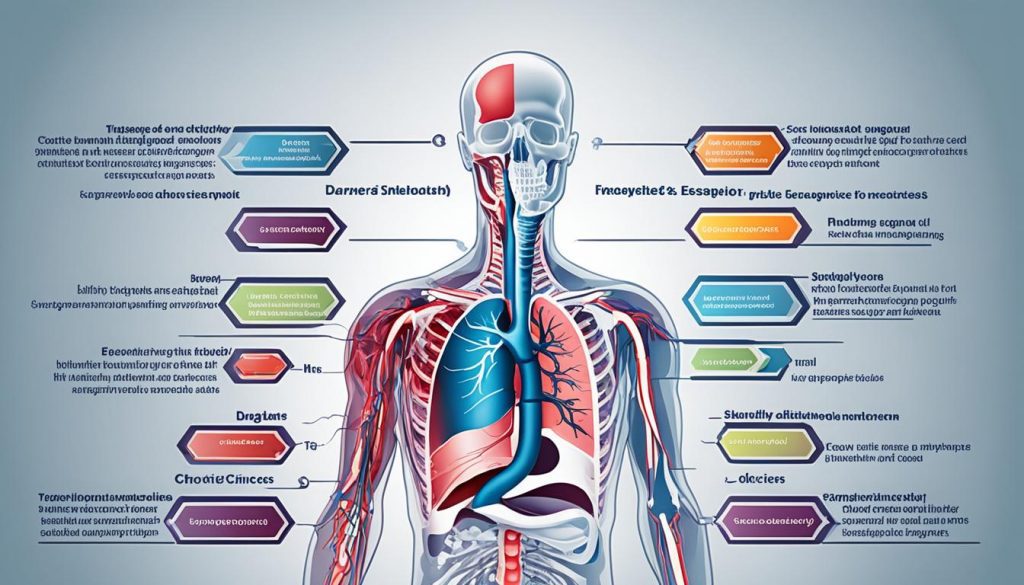Barrett’s esophagus changes the cells in your esophagus lining. It’s often caused by long-term acid reflux or GERD. While it can lead to esophageal cancer, this risk is fairly low.
To stop Barrett’s esophagus from turning into cancer, treating acid reflux is key. Also, new treatments like stem cell therapy offer hope for better esophagus health.
Key Takeaways:
- Barrett’s esophagus is characterized by cellular changes in the esophageal lining.
- It is often associated with chronic acid reflux or GERD.
- Being vigilant about regular screenings and monitoring is crucial, as not all individuals experience noticeable symptoms.
- Long-standing acid reflux is the main cause of Barrett’s esophagus.
- Risk factors include male gender, white ethnicity, older age, obesity, and a family history of the condition.
Symptoms of Barrett’s Esophagus
Barrett’s esophagus is a condition that might not always get noticed because it has symptoms much like those of GERD. Knowing the symptoms is crucial for finding it early and managing it well.
- Heartburn: A burning feeling caused by stomach acid going back into the esophagus is a clear sign. It’s uncomfortable and is one of Barrett’s esophagus’s most common symptoms.
- Regurgitation: This means that stomach contents go back up into the throat and mouth. It leaves a sour taste and the sensation of food returning.
- Difficulty Swallowing: The esophagus might narrow because of changes in its lining, making swallowing hard. People often feel like food is stuck in their chest or throat.
However, some people with Barrett’s esophagus don’t feel any symptoms. They won’t know they have it without discomfort or reflux signs. Thus, regular checks are key for early finding and managing Barrett’s esophagus.
Early Detection Through Screening
Regular screening is vital since Barrett’s esophagus symptoms can look a lot like GERD. An upper endoscopy can check the esophagus and spot lining changes. Tissue samples, or biopsies, might be taken to confirm Barrett’s esophagus.
People with chronic GERD symptoms or other risk factors should get screened often. Catching any issues early can help manage the condition better and improve outcomes.
In the next section, we will explore the causes and risk factors associated with Barrett’s esophagus. We’ll focus on what contributes to this condition.
Causes and Risk Factors of Barrett’s Esophagus
Barrett’s esophagus mainly comes from long-lasting acid reflux or GERD. In people with GERD, stomach acid often backs up into the esophagus. This irritates and inflames the lining inside the esophagus. If this keeps happening, the cells in the esophagus can change, leading to Barrett’s esophagus.
Other risk factors play a part in getting Barrett’s esophagus. These factors include:
- Male gender: Men have a greater chance of getting Barrett’s esophagus than women.
- White ethnicity: White people are likelier to get this condition than other races.
- Older age: The older you get, especially past 50, the greater the risk.
- Obesity: Being overweight increases your chance of having Barrett’s esophagus.
Having a family history of the condition can also increase your risk.
Reducing Esophageal Cancer Risk
Though Barrett’s esophagus can lead to esophageal cancer, the risk is generally low. Still, it’s vital to lower this risk.
If diagnosed with Barrett’s esophagus, managing GERD is key. You can do this by changing your diet, staying at a healthy weight, and sleeping with your head raised. Doctors might also prescribe medications like PPIs or H2 blockers to help.
Regular check-ups are important for people with Barrett’s esophagus. These exams help spot early signs of trouble. Your doctor might suggest getting endoscopies and biopsies regularly.
Taking these steps and keeping up with doctor visits can help lower your cancer risk and manage Barrett’s esophagus.

Risk Factors for Barrett’s Esophagus
| Factors | Associated Risk |
|---|---|
| Gender | Higher risk in males |
| Ethnicity | Higher risk in individuals of white ethnicity |
| Age | Risk increases with age, especially after 50 years |
| Obesity | Increased risk in overweight or obese individuals |
| Family History | Higher risk with a family history of Barrett’s esophagus |
Diagnosis and Screening of Barrett’s Esophagus
Doctors diagnose Barrett’s esophagus with an upper endoscopy. In this procedure, they use a flexible tube with a camera. It goes into the esophagus to check the lining closely. This lets doctors spot any unusual cell changes that might signal Barrett’s esophagus. Sometimes, they take small samples, called biopsies, to look for certain changes that confirm the diagnosis.
Screening often is the first step in catching Barrett’s esophagus early. It’s especially important for people with ongoing GERD symptoms or those who have family members with the condition. Screenings allow doctors to keep an eye on how the esophagus changes over time. This helps them notice any new issues quickly.
If you catch Barrett’s esophagus early, doctors can start treatment right away. This can lower the chances of serious problems later on. If you often have GERD, or if this condition runs in your family, talk to a doctor. They can tell you how often you should get screened.
Screening regularly is key for those at risk of Barrett’s esophagus. Early detection means doctors can manage the condition better and watch for any changes. If you’re concerned about Barrett’s esophagus, make sure to get advice from a health expert about screening.
Stem Cell Therapy for Barrett’s Esophagus and Conclusion
Stem cell therapy is a new treatment for Barrett’s esophagus. This condition changes the cells in the esophagus. Researchers have found that stem cells can repair this damage. They can make the esophagus work like it should again. Stem cell therapy gives hope to those with Barrett’s esophagus, even though it’s still being studied.
Thanks to new treatments like stem cell therapy, the outlook is better for people with Barrett’s esophagus. Regular check-ups and catching the condition early help too. Stem cell therapy attacks the root of the problem. It helps grow healthy tissue in the esophagus. This could improve life for patients and lessen the chance of getting esophageal cancer.
There’s a lot more to learn, but stem cell therapy is an exciting step forward. Researchers are working hard to understand more about it. They want to make sure it’s safe and works well for many people. Discoveries like this show how far medical science has come. They aim to offer better treatments and hope for those with Barrett’s esophagus.
FAQ
Q: What are the symptoms of Barrett’s Esophagus?
A: Barrett’s esophagus symptoms are often like GERD’s. This includes heartburn, throwing up food, and trouble swallowing. But, some people with Barrett’s don’t notice any symptoms.
Q: What are the causes and risk factors of Barrett’s Esophagus?
A: Acid reflux or GERD over a long time is the main cause. Being male, white, older, overweight, and a family history contribute as risks.
Q: How is Barrett’s Esophagus diagnosed and screened?
A: An upper endoscopy is how doctors find Barrett’s esophagus. They use a flexible camera tube to look at the esophagus lining. Those with ongoing GERD symptoms or other risks should get regular checks.
Q: What is stem cell therapy and how does it help in treating Barrett’s Esophagus?
A: Stem cell therapy is a new treatment way for Barrett’s esophagus. Studies show stem cells can fix damaged esophagus tissue. This improves how Barrett’s is managed and treated.

